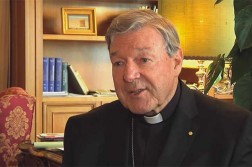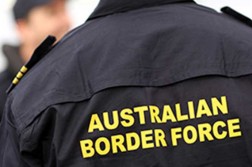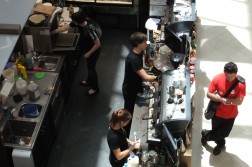What makes a great city? This is the question that occurred to me when I heard the prediction that in 2037, to coincide with the launch of the Rudd Government’s carbon pollution reduction scheme, Melbourne will actually pass Sydney as Australia’s most populous city.
Of course this is just a projection, and many things could happen between now and then — a sudden unexpected influx of economic refugees from Canada; a tactical nuclear strike on Federation Square — but it does raise the question of just which of the two metropolises is the greater. Is Melbourne, as it nears a Sydney-exceeding population, all set to also take on the mantle of Australia’s beacon to the world? Is Sydney prepared to fight to stay number one? Where does Adelaide fit in? Somewhere between Broken Hill and Launceston? The questions are literally infinite, if you’ve got the time, but what I plan to do today is focus on the key question of which city is Australia’s best, and settle it once and for all. I am perfectly qualified to judge this, having spent all my life in one or the other, and therefore having developed the depth of knowledge and sense of jaded apathy that these two sparkling jewels in the Australian crown inspire in their citizens.
Of course, the Melbourne-Sydney rivalry is as old as time itself. It dates back to before white colonisation, when the tribes of the Botany Bay area would deride their southern neighbours’ drab clothing and pretentious cave paintings, while the tribes of Port Phillip would jeer at the northerners’ debauched jamborees and tacky casino.
This carried over to the era of European settlement, when Sydney could boast of its status as the cradle of Australian civilisation, while Melbourne could boast of the fact that it used to be called "Batmania" — a name the abandonment of which is now considered Australia’s greatest peacetime tragedy.
There is no doubt that both cities have their charms. Sydney is a go-getters’ city, full of brash businesspeople, bright lights, big wads of cash and drunken rugby league players lumbering across the landscape like herds of short-tempered, poorly educated musk oxen, grazing on the lush nightclubs and verdant young women of the city. Melbourne, meanwhile, is a more reflective city, full of art and culture and authentically pretentious live music, where business is done in a more genteel way and you can be sexually assaulted by a better class of footballer, who is probably doing a degree in accounting and valuable work with Indigenous youth. One can have a wonderful time in either town: enjoying Sydney’s glitzy sheen; or revelling in Melbourne’s cosy smugness.
Sydney, of course, has the edge in natural beauty. The stunning aesthetic magic of Sydney was obvious even to the very earlier settlers, led by Arthur Phillip, who said, upon first gazing at the spectacular vistas, "This’d be a sweet spot for an IMAX". Its sparkling waters and golden beaches can’t really be matched by Melbourne, with its Yarra River — one of the few major rivers in the world to be officially classified as a smallgood — and its "Docklands" district, an intriguing social experiment to see just how much human beings are willing to pay to live next to construction sites and never go to the shops.
On the other hand, Melbourne has a rich civic life that Sydney can only envy. Melbourne is the friendliest, most community-minded city in the world, as measured by total number of baffling pieces of public art. Sydney may have the Harbour Bridge, the Opera House, and Centrepoint, but they certainly don’t have a giant bird eating cheese beside a freeway, or a bunch of colourful sticks glued on an archway. For that kind of innovative avant-garde cultural audacity, you have to go to Melbourne, where you can hardly find a street corner without a group of bohemian intellectuals arguing furiously about art or politics or philosophy or whether to go into the 7-11 for a sausage roll, or go to the 7-11 across the street instead. It’s a rich human stew, and it’s something that you don’t get in Sydney. If you try to have a philosophical debate on a street corner in Sydney, you’ll get charged $50 for every quarter-hour, and probably be forced to take a shower afterwards.
Because in Melbourne, people aren’t just interested in money and shiny things. In Melbourne, people really, truly care about appearing to be smart and sophisticated and really into Christos Tsiolkas. Mention Christos Tsiolkas in Sydney and they’ll point to the nearest souvlaki bar. They know who he is, they just won’t want to talk to you anymore.
And this is not to denigrate Sydney’s culture, which is diverse and satisfying in its own right, and is not any the worse for including more water-skiing than is strictly necessary. There are a million things to do in Sydney, and if you prefer fireworks and bracing sea air to black skivvies and poetry readings, it’s the place to be. Of course, Melbourne is the place to be if you prefer live bands and tram rides to corrupt politicians and racist surfers.
But every city has its problems. Take traffic, for instance, a perennial problem for major cities. Melbourne has the Westgate bridge, which offers a daily prize to the first caller to guess today’s speed limit, and the novel concept of "hook turns", an innovation based on the idea that traffic flow will be improved if, instead of having cars turn right from right-hand lanes, they drift slowly out in the middle of intersections and get hit by trams.
Sydney, in contrast, has neither trams nor hook turns, but has its own quirks, such as Parramatta Road, a place where people can go to sit in cars and relax for hours on end, admiring other cars and eventually, forming small villages and fascinating subcultures. Many of the current inhabitants of Parramatta Road were born there, and are now raising families of their own, in a heartwarming example of how traffic brings people together.
Then there’s law and order. Here, Sydney might claim to have the edge, with a strong and action-oriented police force that accepts all major credit cards. In contrast, Melbourne has suffered from the disastrous decision to appoint a female police commissioner under the ill-fated "Vaginas Versus Villains" policy which resulted in over 80 percent of the force being reassigned to the full-time gay pride march detail, and the majority of the remainder seconded to the Commissioner’s personal arson squad. Only now is the Victorian police force returning to more traditional operational duties, cutting back on setting fires and gay pride, and concentrating more on complaining about the uniforms and funding legal defences for union officials.
Of course, two such thoroughly Australian cities are bound to have as many similarities binding them together as they do differences tearing them apart, and on many levels Melbourne and Sydney are close relations. Both cities, for instance, have magnificent public transport systems, where everyone who shows up to a railway station has a good sporting chance of getting on a train. Both cities have thriving sporting cultures which revolve around vicious hostility to outsiders. Both cities have been known to go days at a time without a fatal stabbing. And so forth.
But there is no doubt that Melbourne and Sydney are vastly different beasts: one, wrapping itself up in a dufflecoat against the cold, heading out to a wine bar, and listening to some cool jazz while having a deep and meaningful conversation about refugees; the other, tarting itself up in a miniskirt and heels, waxing its chest, and hitting the waterfront for a seafood dinner and a 24-hour pokies session.
But the question is: which is best? It’s not purely a matter of size — Sydney was bigger for many years, and it didn’t make it the best — all the snotty Melburnians bleating about being the "most liveable city" did that — and when Melbourne overtakes Sydney in size, it won’t automatically mean it is the best. The question of which is the better city is one that must be decided on criteria of culture, food, amenities, attractions, good governance, high living standards, and manageable murder rates. It’s not an easy call to make, and if I were not such an astute social scientist I might even declare myself flummoxed at having to choose between two such genuinely wonderful urban wonderlands.
But in the end, a winner must be declared, and there is no doubt that, weighing up all factors and taking all issues into account, balancing pros and cons against each on a totally objective basis, we are forced to the inescapable conclusion that while one city may have paralytic government, horrific congestion, nightmarish housing affordability, and Mount Druitt, the other city makes you turn right from the left-hand lane.
Sorry, Melbourne. You blew it.
Donate To New Matilda
New Matilda is a small, independent media outlet. We survive through reader contributions, and never losing a lawsuit. If you got something from this article, giving something back helps us to continue speaking truth to power. Every little bit counts.



